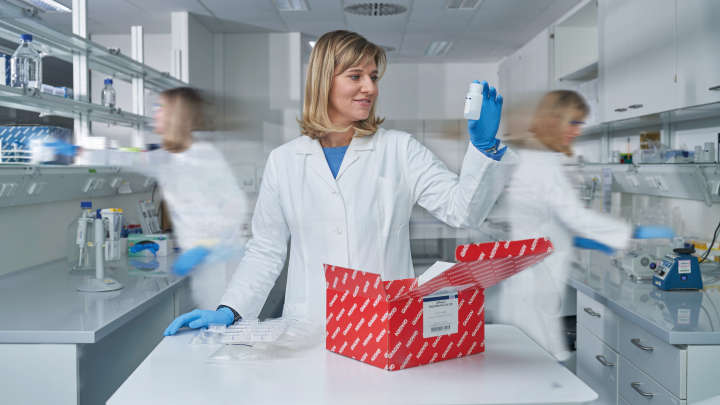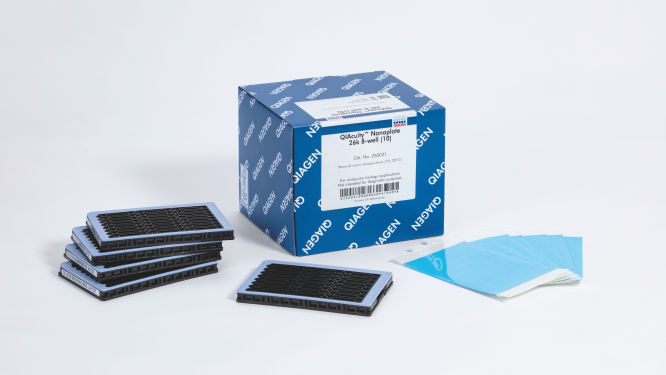✓ Automatische Verarbeitung von Online-Bestellungen 24/7
✓ Sachkundiger und professioneller technischer und Produkt-Support
✓ Schnelle und zuverlässige (Nach-)Bestellung
QIAcuity Nanoplate 26k 8-well (10)
Kat.-Nr. / ID. 250031
✓ Automatische Verarbeitung von Online-Bestellungen 24/7
✓ Sachkundiger und professioneller technischer und Produkt-Support
✓ Schnelle und zuverlässige (Nach-)Bestellung
Eigenschaften
- Vier Nanoplatten für unterschiedliche Anwendungsbereiche
- Bis zu 8.500 oder 26.000 Partitionen je Kavität
- SBS-Format
Angaben zum Produkt
Die QIAcuity Nanoplates sind Platten für die mikrofluidische digitale PCR, die die Analyse von 8, 24 oder 96 Proben mit bis zu 8.500 oder 26.000 Partitionen je Kavität ermöglichen. Alle vier Nanoplatten sind für den Einsatz auf QIAcuity Digital-PCR-Geräten optimiert.
Die Nanoplatten können ausschließlich mit dem QIAcuity Digital PCR System verwendet werden. Für das automatisierte Flüssigkeitsmanagement und PCR-Setup mit einer QIAcuity Nanoplate auf dem QIAgility wird der spezielle QIAcuity Nanoplate Adapter benötigt. Laden Sie die fertig befüllte Platte in das QIAcuity Digital PCR System.
Möchten Sie Näheres über das Produkt erfahren und von einem unserer dPCR-Spezialisten kontaktiert werden? Registrieren Sie sich hier, und wir werden uns umgehend mit Ihnen in Verbindung setzen.
Leistung
Dies sind speziell für die digitalen PCR-Reaktionen in den QIAcuity Geräten entwickelte Platten. QIAGEN bietet vier Nanoplattentypen an, alle im SBS-Format, aber mit unterschiedlichen Spezifikationen für verschiedene Anwendungsbereiche.
| Typ | Rahmenfarbe | Spezifikationen | Anwendungen |
| Nanoplate 26K 8-Well | Hellblau |
8-Well x rund 26.000 Partitionen 40 µl dPCR-Reaktion je Kavität |
Nachweis seltener Mutationen, Flüssigbiopsie, Genexpressionsanalyse, Nachweis von Krankheitserregern usw. |
| Nanoplate 26K 24-Well | Blau |
24-Well x rund 26.000 Partitionen 40 µl dPCR-Reaktion je Kavität |
Nachweis seltener Mutationen, Flüssigbiopsie, Genexpressionsanalyse, Nachweis von Krankheitserregern, usw. |
| Nanoplate 8.5K 24-Well | Weiß |
24-Well x rund 8.500 Partitionen 12 µl dPCR-Reaktion je Kavität |
Analyse von Kopienzahlvariationen, Genexpressionsanalyse, Quantifizierung von NGS-Bibliotheken, Erkennung von Genomveränderungen, usw. |
| Nanoplate 8.5K 96-Well | Grau |
96-Well x rund 8.500 Partitionen 12 µl dPCR-Reaktion je Kavität |
Prinzip
In 3 einfachen Schritten erhalten Sie in weniger als 2 Stunden das gewünschte dPCR-Ergebnis: pipettieren und laden, Experiment durchführen, Ergebnisse auswerten. Das Prinzip der dPCR-Reaktion in den Nanoplatten finden Sie hier beschrieben.
Verfahren
Genau wie bei qPCR-Experimenten umfasst die Probenvorbereitung die Überführung von Master-Mix, Sonden und Primern in eine 8-, 24- oder 96-Well-Nanoplatte, gefolgt von der Zugabe der Proben. Das System integriert Partitionierung, Thermocycling und Bildgebung in nur einem vollautomatischen Gerät, mit dem Sie in weniger als 2 Stunden von der Probe zum Ergebnis gelangen. Mit der Software Suite lassen sich Auswertungen durchführen, die die Konzentration der Zielsequenz in Kopien pro Mikroliter sowie Qualitätskontrollen wie positive Proben und NTC liefern. Diese Auswertung kann auch auf Remote-Computer innerhalb desselben lokalen Netzwerks (LAN) ausgedehnt werden.
Anwendungen
Im Zusammenspiel mit dem QIAcuity Digital PCR System und den QIAcuity PCR Kits ermöglichen die QIAcuity Nanoplates digitale PCR-Anwendungen wie z. B.:
- Nachweis seltener Mutationen
- Auswertung der Variation der Kopienzahl
- Genexpressionsanalyse
- Pathogennachweis
- Genotypisierung
- miRNA-Forschung
- Zell- und Gentherapie
- Quantifizierung von Rest-DNA
- Abwasserüberwachung

